How to Conduct a Fire Risk Assessment: The Complete UK Guide
Table of contents
Table of Contents
- How to Conduct a Fire Risk Assessment: The Complete UK Guide
- Introduction: Why Fire Risk Assessments Save Lives and Livelihoods
- The 5-Step Fire Risk Assessment Process
- Fire Risk Assessment Costs: What to Expect
- Types of Fire Risk Assessments for Residential Buildings
- Penalties for Non-Compliance
- Assessor Competency and Common Mistakes
- Conclusion: Protecting Lives Through Effective Fire Risk Assessment
- Take Action: Professional Fire Risk Assessment Services
Introduction: Why Fire Risk Assessments Save Lives and Livelihoods
Picture this: A small electrical fault in a commercial kitchen goes unnoticed during a routine inspection. Three months later, it ignites flammable cooking materials during the night. Without adequate fire detection, compartmentation, or evacuation procedures, the result is catastrophic—not just property damage, but potential loss of life and a criminal prosecution that could result in imprisonment.
This isn’t fear-mongering. It’s the reality for businesses that fail to properly conduct and maintain fire risk assessments.
In the UK, fire kills over 200 people annually and injures thousands more. Many of these tragedies are preventable through proper fire safety management. The Regulatory Reform (Fire Safety) Order 2005 makes fire risk assessments a legal requirement for virtually all non-domestic premises—and for good reason.
But here’s what most building owners and managers don’t realize: A fire risk assessment isn’t just a compliance box-ticking exercise. When done properly, it’s a comprehensive safety strategy that identifies vulnerabilities, protects occupants, and shields you from devastating legal and financial consequences.
This guide provides everything you need to understand and implement a thorough fire risk assessment process. Whether you’re a business owner, property manager, or responsible person, you’ll learn the exact methodology used by professional fire safety consultants, understand your legal obligations, and discover how to create a robust fire safety management system that actually works.
The 5-Step Fire Risk Assessment Process
The UK government and fire safety professionals follow a standardized five-step methodology. This systematic approach ensures nothing is overlooked and provides a consistent framework for documenting and managing fire safety.
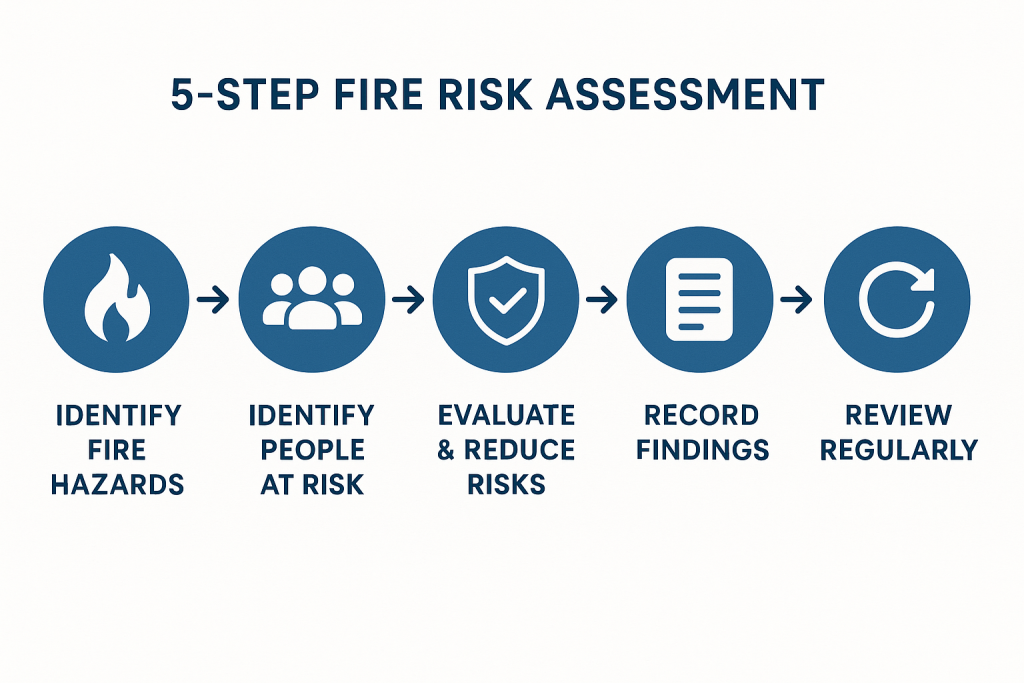
Step 1: Identify Fire Hazards
The first step involves a thorough inspection of your premises to identify anything that could cause a fire or make a fire worse. You’re looking for three key elements: ignition sources, fuel sources, and oxygen.
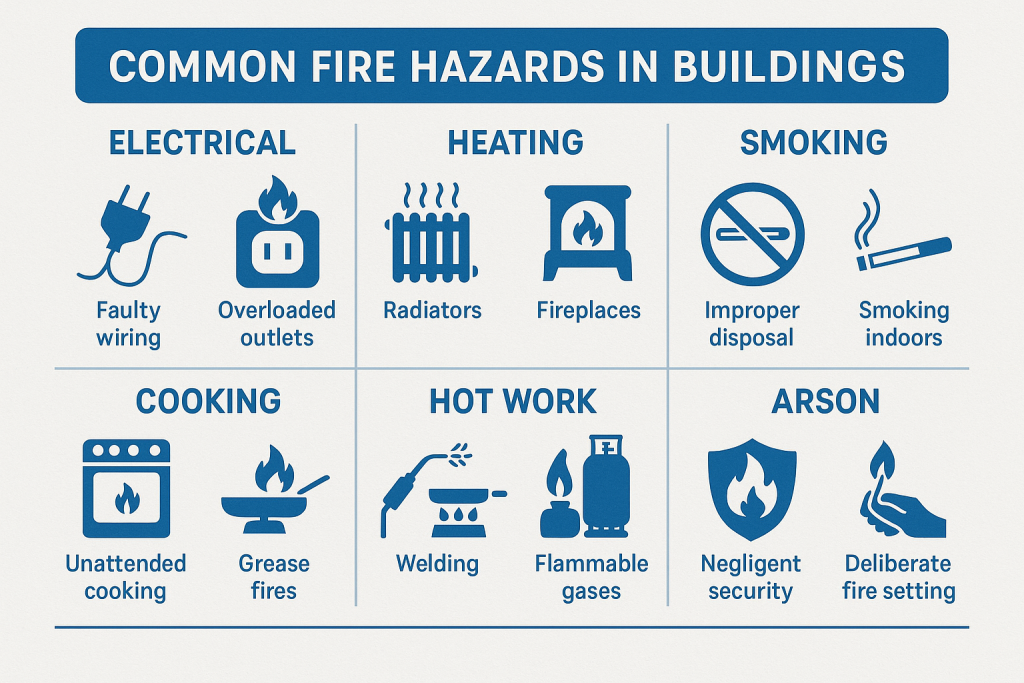
Common Ignition Sources
Ignition sources are anything that can generate sufficient heat to start a fire:
- Electrical equipment: Faulty wiring, overloaded sockets, damaged appliances, portable heaters
- Smoking materials: Cigarettes, vapes, lighters
- Cooking equipment: Commercial kitchens, staff break rooms
- Heating systems: Boilers, radiators, open flames
- Hot work: Welding, grinding, cutting operations
- Arson: Deliberate fire-setting, which requires specific security considerations
Fuel Sources and Combustible Materials
Fuel sources are materials that can burn. The challenge is that virtually everything burns given sufficient heat:
- Combustible building materials: Wood structures, decorative panels, insulation
- Furnishings: Furniture, curtains, carpets
- Paper and packaging: Documents, cardboard boxes
- Flammable liquids: Cleaning products, paints, solvents
- Waste materials: Rubbish bins, recycling
Understanding Fire Classifications
Professional fire risk assessments categorize fire hazards by class, which determines appropriate suppression methods:
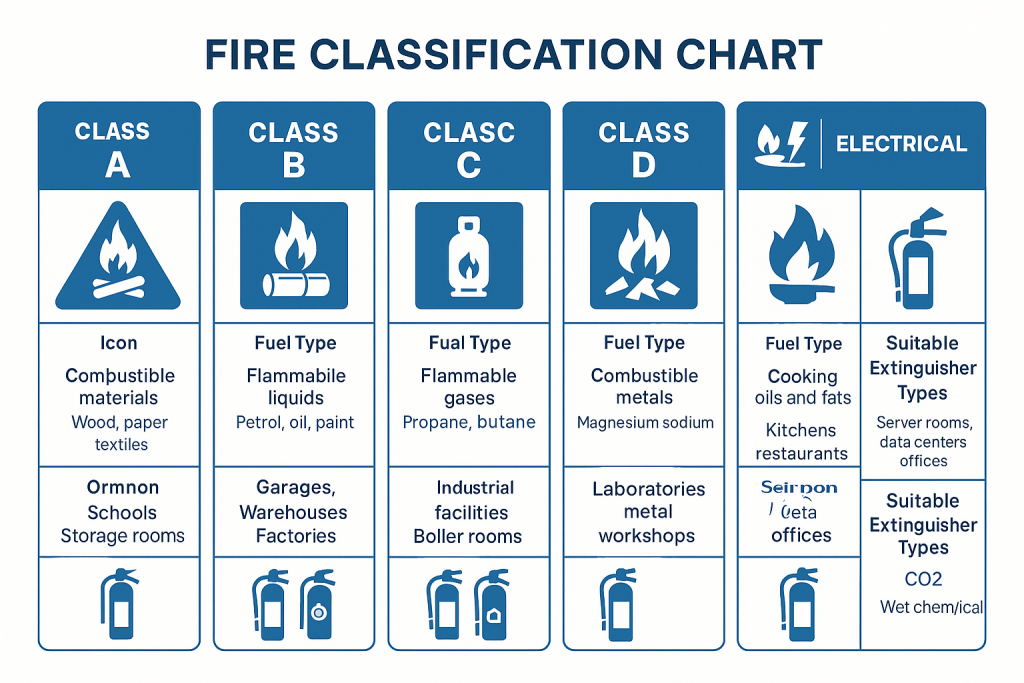
Step 2: Identify People at Risk
Once you’ve identified fire hazards, the next step is determining who could be harmed by fire and how they might be affected. This goes beyond simply counting occupants—you need to understand their specific vulnerabilities and circumstances.
Vulnerable Persons and Special Considerations
- Disabled Persons: People with mobility, visual, or hearing impairments require specific evacuation considerations, often detailed in Personal Emergency Evacuation Plans (PEEPs).
- Children: Premises like schools and nurseries require enhanced protection and supervision.
- Elderly Persons: Care homes house people with reduced mobility or medical conditions that limit their ability to escape quickly.
- Sleeping Occupants: People in hotels, residential care, or HMOs face higher risks because fire can develop substantially before detection during sleep hours.
Step 3: Evaluate, Remove, and Reduce Risks
After identifying hazards and vulnerable persons, you evaluate the level of risk and implement measures to eliminate or control it. Professional assessors use a risk matrix to evaluate the likelihood and potential consequences of a fire.
Based on the risk level, you must implement control measures. These include:
- Fire detection and warning systems: Smoke detectors, heat alarms, and manual call points.
- Fire suppression equipment: Fire extinguishers, sprinkler systems, and fire blankets.
- Safe escape routes: Clearly marked, unobstructed emergency exits and corridors.
- Structural fire protection: Fire doors, fire-resistant walls, and compartmentation to slow the spread of fire.

Step 4: Record Findings and Create an Action Plan
If you employ five or more people, you are legally required to record the significant findings of your fire risk assessment. This record should include:
- The fire hazards you have identified.
- The people who are at risk.
- The actions you have taken to reduce the risk.
- An emergency plan for the premises.
Your action plan should prioritize the most urgent risks and set realistic deadlines for completion.
Step 5: Review and Update Regularly
A fire risk assessment is a living document. It must be reviewed regularly (at least annually) and updated whenever there are significant changes to the premises, processes, or people involved. This ensures your fire safety measures remain effective over time.
Fire Risk Assessment Costs: What to Expect
Understanding fire risk assessment cost helps you budget appropriately and recognize unrealistically cheap quotes that likely indicate an inadequate assessment.
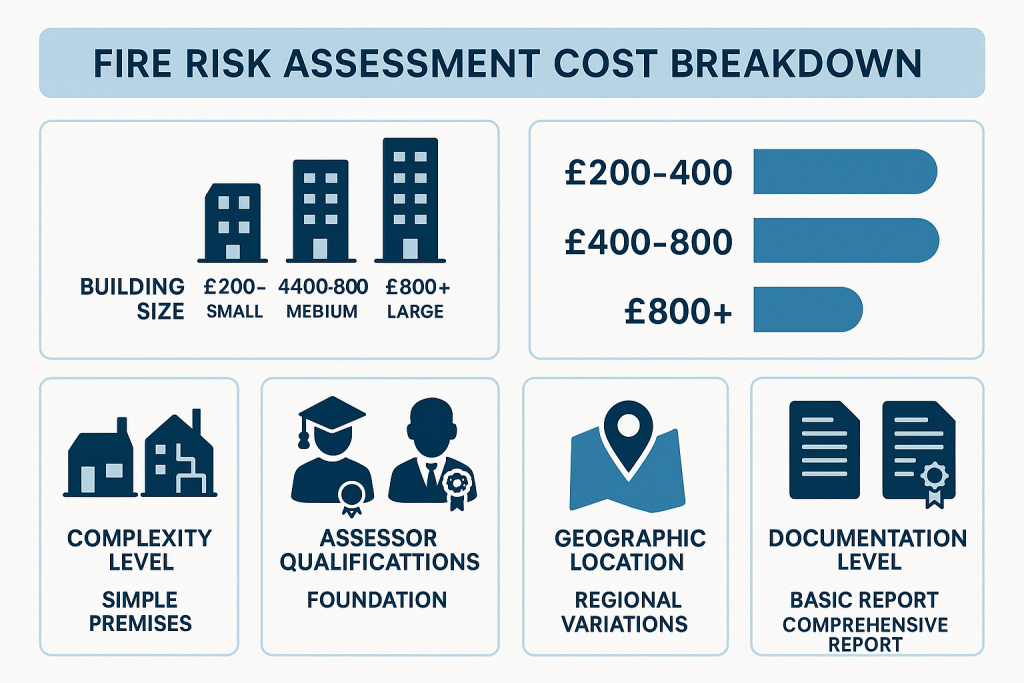
Typical Cost Ranges
- Small, Simple Premises: £200 – £400
- Medium Premises: £400 – £800
- Large or Complex Premises: £800 – £1,500+
- Residential Buildings (Type 1): £300 – £1,200+
Types of Fire Risk Assessments for Residential Buildings
For residential buildings like blocks of flats, different types of assessments are available depending on the building’s complexity and risk level.
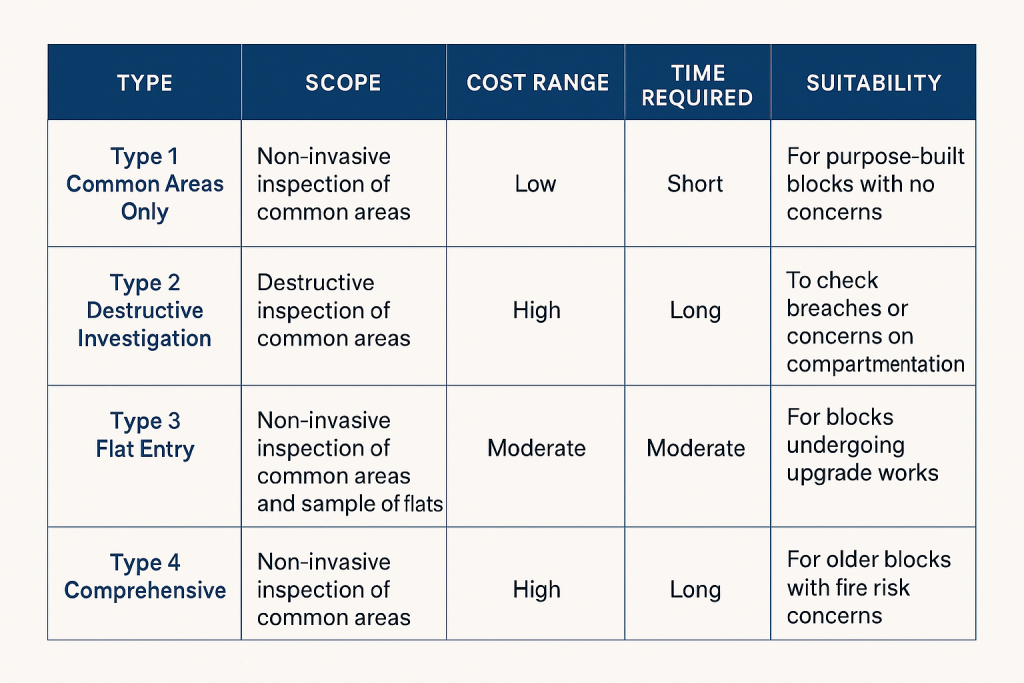
Penalties for Non-Compliance
Fire safety legislation carries significant penalties. Failure to comply can lead to unlimited fines and even imprisonment. Fire and Rescue Authorities can issue improvement notices, prohibition notices, or even close premises immediately if they find serious deficiencies. In the event of a fire that results in death, individuals and corporations can face manslaughter charges.
Assessor Competency and Common Mistakes
Choosing a competent assessor is crucial for a valid and effective fire risk assessment. Look for assessors with relevant qualifications and experience, and be wary of those who offer unrealistically cheap or quick assessments.
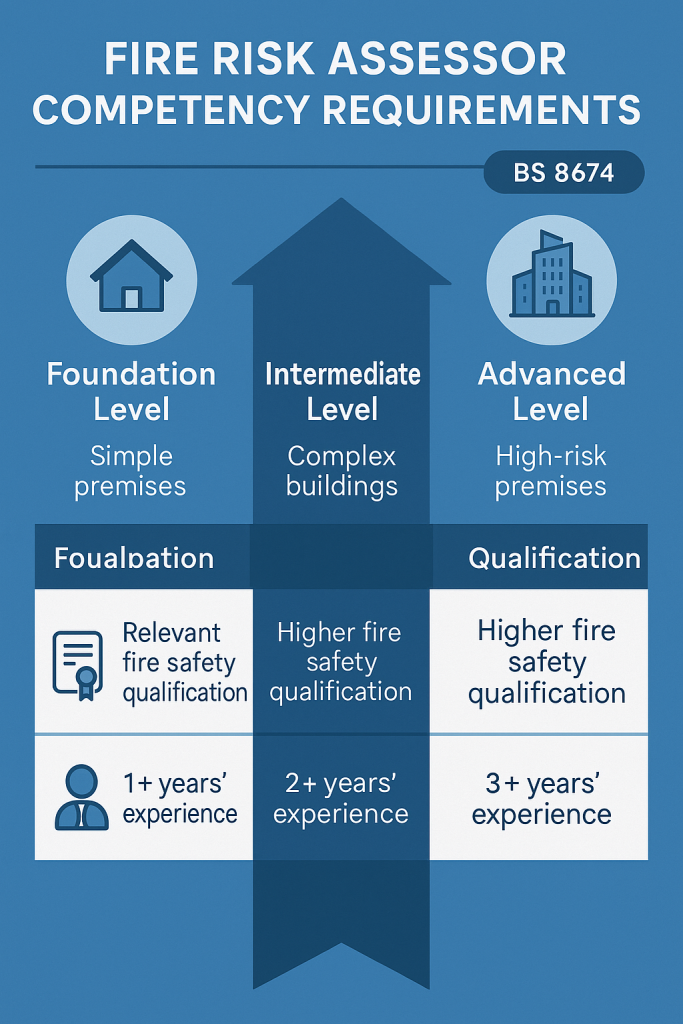
Even with a competent assessor, common mistakes can undermine the process. Avoiding these pitfalls is essential for robust fire safety.
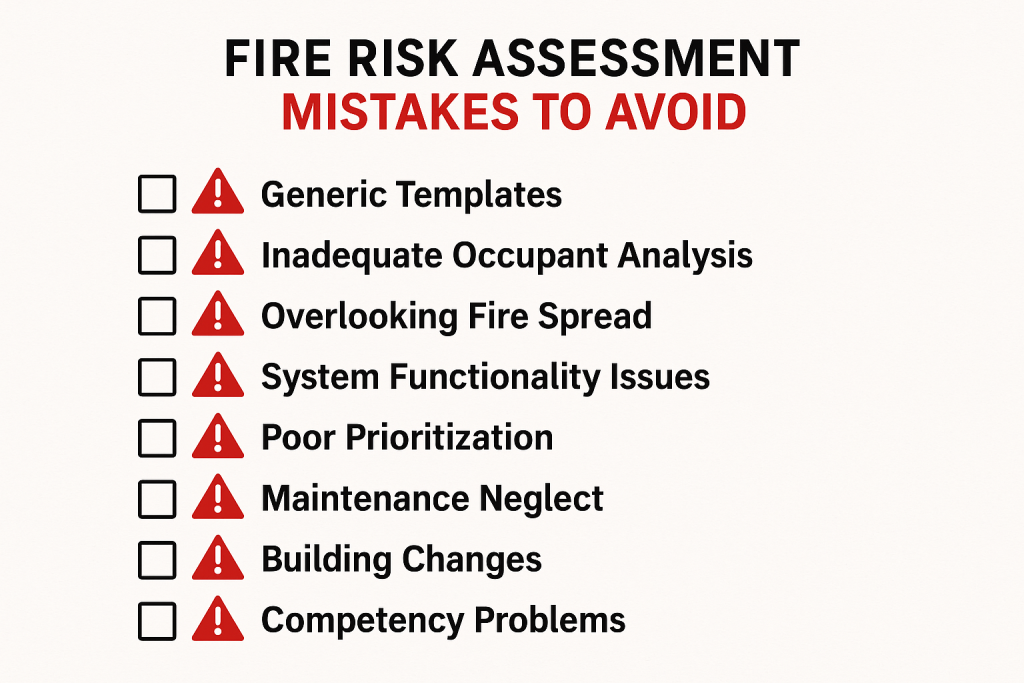
Conclusion: Protecting Lives Through Effective Fire Risk Assessment
Fire risk assessment isn’t bureaucratic box-ticking—it’s a systematic process that identifies vulnerabilities before they become tragedies. By following the five-step methodology, choosing a competent assessor, and regularly reviewing your assessment, you can create a safe environment for everyone in your premises.
Key Takeaways:
- Fire risk assessment is mandatory.
- Competency matters.
- Assessment is ongoing.
- Documentation protects you.
- Implementation is everything.
Don’t leave fire safety to chance. A professional fire risk assessment is a critical investment in the safety of your occupants and the future of your business.
Take Action: Professional Fire Risk Assessment Services
If your premises require a professional fire risk assessment, contact our expert team for comprehensive fire safety solutions. Our qualified assessors provide thorough, bespoke assessments tailored to your specific needs.
Get started with our fire risk assessment cost and timeline calculator for an instant quote, or contact us directly to discuss your requirements.

